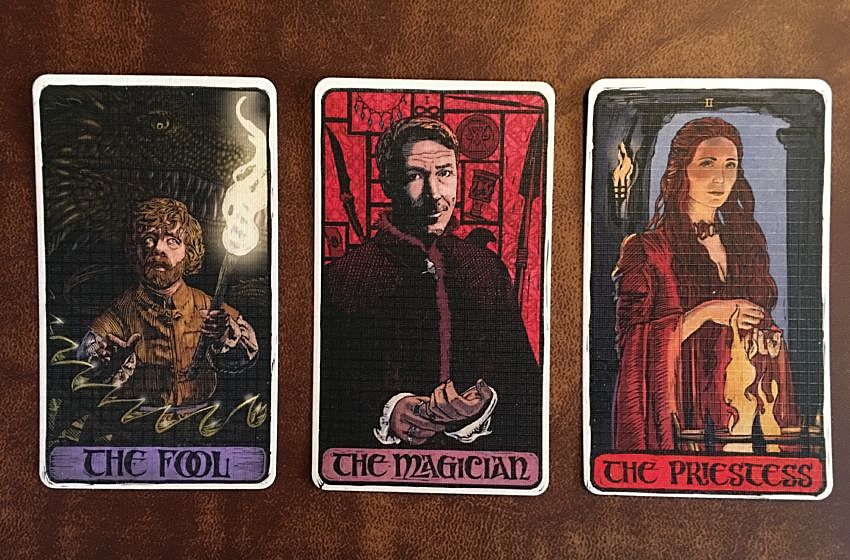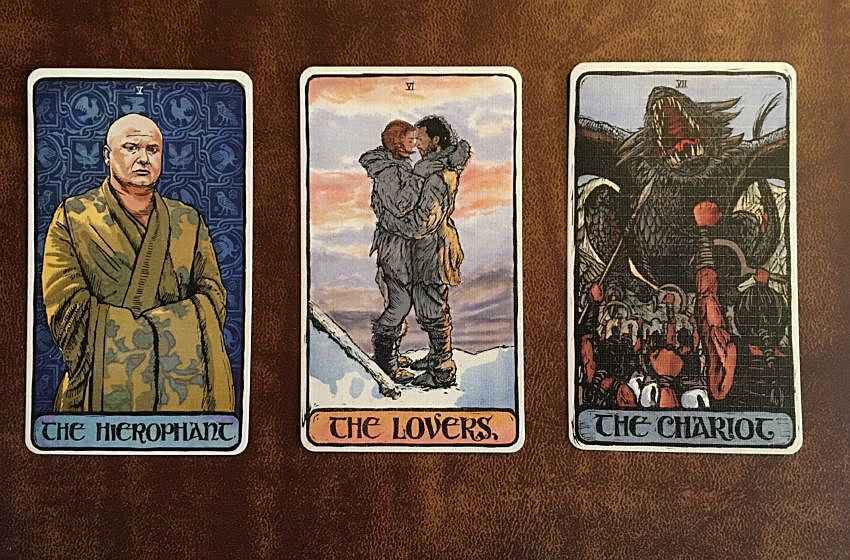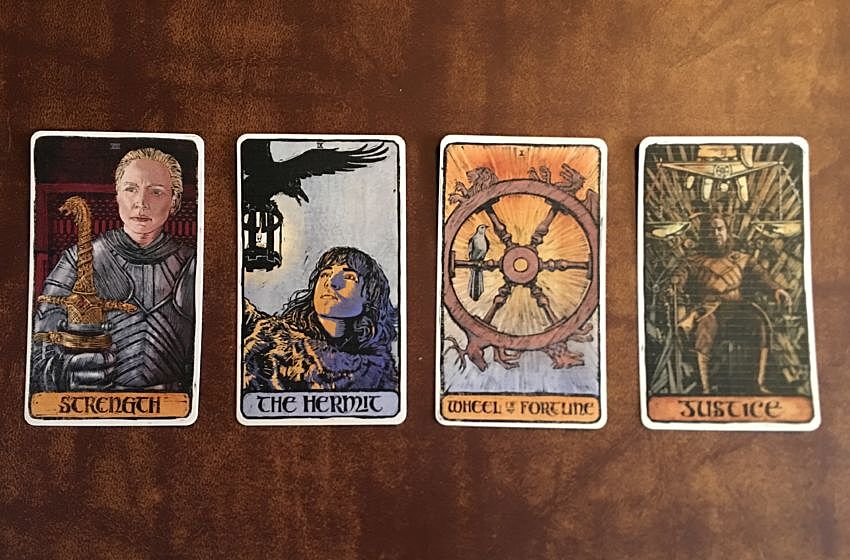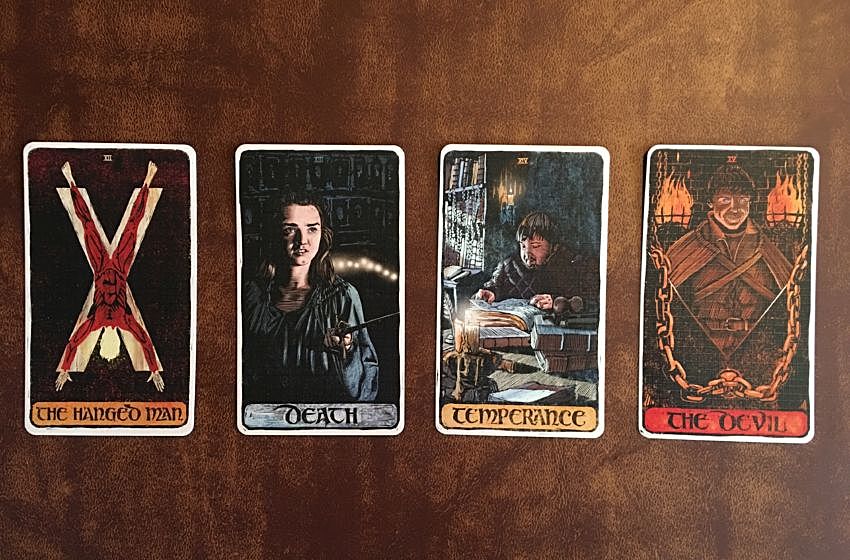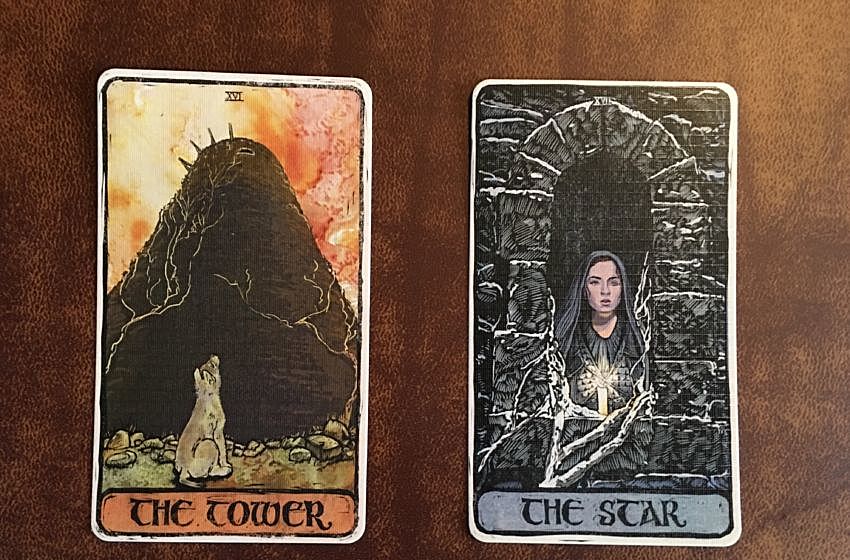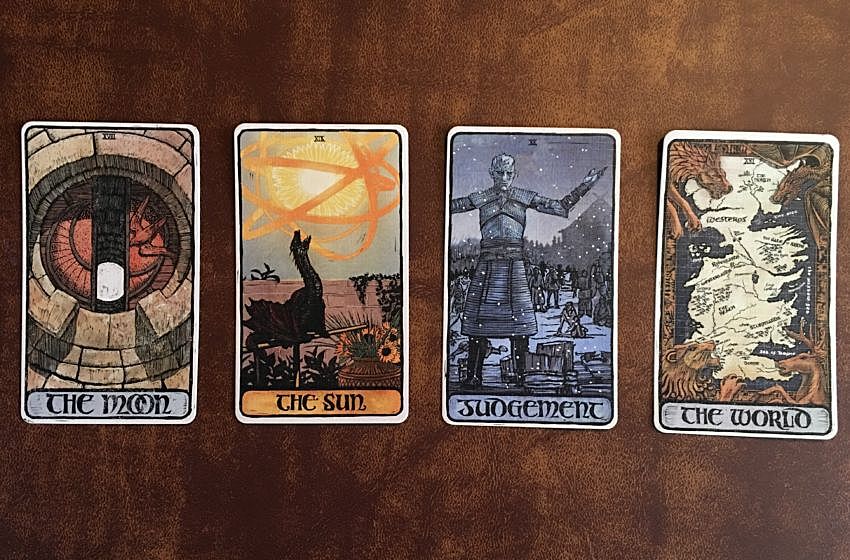Despite common misconception, tarot reading and fortune-telling are not one and the same. Tarot cards do not tell the future, but rather supply food for thought for the here and now. From what’s troubling you to new opportunities on the horizon, tarot helps you to evaluate how to tackle trials, victories, and all the potential in-betweens. Rather than the concrete answers for which your local carnival psychic will wildly overcharge, tarot provides insight and promotes introspection.
While the cards themselves have specific meanings, your reading of them is open to interpretation, very much like a good character analysis, which dovetails nicely with the new Game of Thrones tarot deck.
The deck comes with a guidebook that includes the tarot card catalogue (as well as affiliations between the characters and their cards) and various spreads to suit each reading. As for the character analysis, we’re all seasoned Game of Thrones fans by now, so let’s see what the cards have to say about the cast.
The Major Arcana
The first 22 cards (marked as 0-XXI) are the major arcana, and are linked to the events that affect your life overall. Tarot beginners might want to start with these cards alone, and set the minor arcana aside until they’ve familiarized themselves with the basics.
0. The Fool: Tyrion Lannister
The Fool represents risk, youth and innocence, and new beginnings. It brings to mind not a fool in the negative sense of the word, but more in the Shakespearean vein — one who speaks their mind, and comments freely on the goings-on around them. While the latter may be very well-associated with Tyrion, on the whole I think Bran Stark is better suited to other aspects of the card. When flipped upright, the Fool marks a new phase, either physical or mental. When reversed, it warns that idealism can lead to rash decisions — all of which has applied to Tyrion in some ways, but more so in Bran’s journey in becoming the Three-Eyed Raven.
We do, however, see Bran later in the major arcana in an equally suitable role. So Tyrion is, at the least, an apt choice for the Fool in his stead.
I. The Magician: Petyr Baelish
The number “1” is associated with the individual and the ego, and as such, the card fits this character to a tee. The Magician is all about communication, and how it can be manipulated for or against you, which illustrates the rise and fall of Littlefinger over an impressive seven seasons. As the audience saw in the end, Littlefinger’s schemes and political machinations ultimately led to his downfall — one that he might have seen coming, had he not been so engrossed by his own cleverness. The reversed Magician cautions against deception afoot, which ties into Littlefinger’s death.
II. The Priestess: Melisandre
Melisandre is the clear choice for this card, as “priestess” is in her very title. Key details include intuition and all things spiritual, as well as feminine power. Both the upright and reversed positions of the Priestess fit Melisandre. While she encourages others to embrace the spiritual, Melisandre and the reversed Priestess encapsulate the spread of misinformation and potentially broken faith.
III. The Empress: Daenerys Targaryen
IV. The Emperor: Jon Snow
Although these cards — when turned upright during a reading — usually denote positivity in a relationship, Daenerys and Jon’s appearance as the Empress and Emperor does not foretell a particularly positive future. When reversed, the cards speak of a power imbalance; the Emperor in particular feels controlled. This suits Jon’s season 7 arc overall, as he arguably spends several episodes as Daenerys’ prisoner, and ends the year not as her equal, but subservient.
A character like Catelyn Stark — whose arc was defined by dedication to her children and finding peace for her family — might have better suited the Empress. But I suppose when it comes to Game of Thrones, we can’t talk maternity without discussing the Mother of Dragons. Daenerys did, in a sense, rebirth magic into Westeros when her dragons hatched, and her role as their mother has strongly impacted her character and plotline.
Besides, when we consider that these cards represent two sides of the same coin, it’s rather fitting that the chosen characters would be Daenerys and Jon. After all, you know what they say about Targaryens and coins…
“The Targaryens have always danced too close to madness. King Jaehaerys once told me that madness and greatness are two sides of the same coin. Every time a Targaryen is born, the gods toss a coin in the air and the world holds its breath to see how it will land.”
V. The Hierophant: Varys
The Hierophant is one who unearths and interprets sacred mysteries. While Varys himself is not a religious character, we learn that he has been negatively influenced by sorcery.
Like the Magician, the Hierophant is associated with communication. This jives with Varys’ character as well as it does Littlefinger’s, as both have played the role of spymaster and mentor. In Varys’ case, the Hierophant speaks to his own pitfalls while advising various leaders — from Ned in season 1 all the way to Daenerys in season 7 — in that the reversed card suggests a wrong direction, and the necessity to bow out in search of a better alternative. Varys is constantly on the lookout for a better option, any person who will improve the Seven Kingdoms for all. He revealed that his allegiance isn’t to any one ruler, but to the common people, and his efforts will go to securing their livelihood.
VI. The Lovers: Jon and Ygritte
Although Game of Thrones has a plethora of romantic relationships to choose from, Jon and Ygritte do best embody the Lovers as they appear in the tarot. When the card is drawn in the upright position, it’s generally a positive reading, but it can also mean making a choice between two loves. In Jon’s case, that decision was between his love for Ygritte and his duty to the Night’s Watch, which also echoes the card in reverse: Dishonesty in relationships, and the need to make a seemingly impossible choice.
VII. The Chariot: Drogon
Daenerys’ favorite child is the focal point of this card, but it’s the scene depicted on the Chariot that demands attention. The sketch is a replica of Daenerys’ speech to the Dothraki in season 6, when she encouraged them to cross the Narrow Sea to help her claim the Iron Throne.
Both the upright and reverse positions of the Chariot perfectly illustrate this moment: Determination, progress, and the potential for glory, as Daenerys finally begins her journey to Westeros; but also an unchecked ego and abuse of power, which she demonstrates in her rallying cry to destroy her enemies by any means necessary.
VIII. Strength: Brienne of Tarth
While there are others who could certainly fulfill the physical aspect of Strength — the Hound comes immediately to mind — it’s Brienne who encompasses the heart of the card.
In its most straightforward reading, Strength is perfectly applicable to Brienne, who is arguably the truest knight in all of Westeros. She is strong of body, mind, and heart alike; the card’s elements of courage, resilience, and compassion are Brienne’s most defining traits, along with her loyalty, which is the driving force behind her character.
Even when that loyalty is pledged to one person, it extends to their family — as we see in Brienne’s devotion to the Stark children — and the causes for which they fight. We see this most assuredly when Brienne tells Jaime to “Fuck loyalty,” as the North and its allies call for an armistice for the sake of the oncoming war against humanity.
IX: The Hermit: Bran Stark
Considering the sheer amount of time Bran spent off-screen (with no appearances in season 5) and later confined to a tree, it’s no small wonder that he’s taken the role of the Hermit. This tarot denotes solitude, reflection, truth, and self-healing.
When reversed, the Hermit reminds you that, despite your isolation, you still have a support system, and it’s wise to seek their help once the time for reflection is done. Bran has the company of the Three-Eyed Raven, Meera, Hodor, and Summer. But once he takes on the role of the Three-Eyed Raven himself, he continues to shut out everyone else — even Sansa and Arya, once the Starks are reunited at Winterfell.
At this juncture, Bran is still very much the upright Hermit, as he continues alone on his path to enlightenment. This, as we see, involves Bran uncovering not only his own destiny, but discovering the truths that have been hidden for generations. For all of the effort of Thrones’ resident spies Varys and Littlefinger, for all of Tyrion’s cleverness, no one holds the key to all of Westeros’ secrets to the degree of Bran Stark.
X. Wheel of Fortune: “The Wheel”
As described in Daenerys’ well-worn “Break the Wheel” speech, that wheel of power takes the place of the tarot’s Wheel of Fortune. All in all, this card is about improvement — everything finds its place as it’s meant to be. Although Daenerys describes the wheel in the negative, the tarot version is not a judgement of better or worse, right or wrong; it simply is.
So what might this imply about Daenerys’ intentions to break the wheel? Perhaps nothing — it may just be that the wheel of power in Westeros was the obvious choice for the Wheel of Fortune. Or it could signify that everyone’s ambitions are all for naught, because fate will be playing the final hand in all of the characters’ stories.
XI. Justice: Ned Stark
As admirable as the late Eddard Stark’s honor — along with his quest for equality, balance, and proclivity to “do the right thing” — was, it ultimately spelled his demise. Ned often played judge, imposing his own morals onto others, and expecting that everyone would do as he would. Such idealism and compassion prompted him to tell Cersei of his intentions to reveal the truth of her children’s parentage to Robert Baratheon. Because to him, doing the right thing meant making sure that Joffrey, Myrcella, and Tommen would not pay the price for their parents’ sins, as he knew Robert would attempt.
Ned sought fairness and honor, and as such, he fell victim to Justice’s reverse side: a suffering of injustice, unfairness, ill treatment, and personal atonement for your mistakes. Ned paid the price for his honor and honesty with his own unfair death.
XII. The Hanged Man: The Flayed Man
While the Bolton sigil is the best physical manifestation of the Hanged Man, a better choice for the card would have been Theon Greyjoy (who, regretfully, does not appear in the deck at all). As Ramsay’s hostage and plaything throughout much of the series, Theon is, of course, heavily associated with the Boltons. There is some focus on his development in the Thrones tarot guidebook. But he could have easily held his own as the Hanged Man, with its themes of transition, reversal, and sacrifice.
XIII. Death: Arya Stark
No one recites a personal hit list like Arya Stark, so it stands to reason that she should portray Death. But the card does not actually mean death in the literal, physical sense — rather, a symbolic one that makes way for new beginnings. When upright, it can also mean realizing the truth. Much like Bran as the Hermit, Arya as Death catalogues her realization of who she was meant to be all along. When reversed, the card heralds the same call to change, only with the more negative connotations of anger and grief, and the need to let those emotions go in order to move on. This is just as Arya must do: Abandon her quest for vengeance, and return home to heal.
The card’s key characteristics of loss, transformation, release, and truth played a major role in her development from one identity to the next, until she reaffirmed her true self at the end of season 6. No longer willing to play at No One, she declared herself “Arya Stark of Winterfell,” and she’s going home.
XIV: Temperance: Samwell Tarly
Aside from Shireen Baratheon (rest her soul), Sam Tarly is the most studious character in the series, and well-suited to the card on which he appears. Temperance is adjustments, balance, tests, and choices. When reversed, the card warns that emotions may be getting in the way of more mental pursuits, which is a conflict Sam struggled with during his tenure at the Citadel. The card urges you to be mindful of the present, while Sam pushed boundaries to achieve all of his endeavors more quickly.
When upright, Temperance encourages you to give others only what is necessary, but to ensure that you have energy to focus on yourself. This plays into Sam’s workload at the Citadel, as he was so inundated with tasks and menial chores that he occasionally lost faith in what he was meant to be doing.
Ultimately, though, we see Sam use his more-than-once cracked patience to serve the greater good, which allowed for a more no-nonsense side of him to emerge and take charge. Most notably through season 6-7 — when he defies his abusive father, and later foregoes the Citadel’s protocols and eventually abandons his study — Sam finally, definitively struck that balance between who he’d been and who he has the potential to become.
XV: The Devil: Ramsay Bolton
This one might be even more obvious than “The Wheel” as the Wheel of Fortune. As the Devil is defined by temptation, lust, and rage, Ramsay indulges in his own predilections for cruelty and violence to excess. If he can’t use or manipulate a person, he destroys them — not in any clever or political way, but simply by means of death.
The card warns against overconsumption of short-term pleasures, and implores the reader to consider the long-term consequences. Ramsay, although a shrewd man, at some points also lacked self-control. His apparent enjoyment of torture blinded him to how that torture could become his own. Thats what happened when Ramsay died at the hands of his wife and victim, Sansa Stark, who left him just as helpless as he’d made her and countless others.
XVI: The Tower: The Broken Tower
Like the Wheel, this is an obvious but nevertheless accurate connection. The card depicts the first time we see the Broken Tower in season 1, as Summer watches Bran climb its walls. The Tower in tarot is representative of chaos, shock, and revelations — all of which apply to Bran’s situation, and the chaos that followed his discovery of Jaime and Cersei’s incestuous relationship (which is also illustrated in the card, as it draws attention to relationship secrets).
XVII: The Star: Sansa Stark
The Broken Tower makes another appearance in the major arcana in The Star, where Sansa Stark takes center stage as she lights her candle for help in season 5. The scene is an apt illustration for the card’s meaning: hope and healing, as Sansa awaits rescue and eventually makes her own break for it.
When reversed, the Star signifies either lack of support or lack of personal perseverance. Sansa is alone through most of her time on the show and particularly during her stay at the Boltons’ Winterfell, never having a steady or altruistic confidante until she reunites with Jon in season 6. But still she personifies the Star in its upright position: faithfulness, renewal, and the realization of your life’s purpose — all of which we see in Sansa’s progress through seasons 6 and 7.
When the Star turns upright in a reading, it also speaks highly for your romantic future. If you’re looking for love, you’re now ready to find it in its truest form; the card speaks plainly of not only finding, but being with your soulmate. Now, I don’t want to put too much faith in these cards, but I’m always ready to endorse a happy ending for Sansa — one that comes full-circle from what she thought she wanted in season 1, to what she really wants by series’ end.
XVIII: The Moon: The Moon Door
This card seems to be another one that relies more heavily on word association than any parallels between the card itself and what appears on it. As the guidebook describes it, “The moon door is a symbol of cruelty, uncertainty and illusion — will we endure, or as Lysa Arryn says to Sansa Stark, be broken ‘like eggs dropped on the floor’?”.
The Moon in tarot, however, suggests that you may be feeling confused to the point that decision-making seems impossible, however necessary. When reversed, the card suggests that you try to control your emotions and lower your expectations. Nearly everyone in Game of Thrones could benefit from such a tactic, and then we wouldn’t have so many people vying for the same throne. But as that is not the case, perhaps the moon door really was the best candidate for the card.
XIX: The Sun: Drogon
Unlike his role as the Chariot, this depiction of a young Drogon speaks of optimism, happiness, and overall positivity. Even when reversed, the Sun’s reading does not change — it is a card wholly of good vibes. While the dragons have grown beyond good vibes to terrifying weapons of mass destruction, their initial birth was a hopeful one, so the card is accurate in its way. There aren’t many available choices otherwise — although my vote would be for Podrick Payne, who is forever a beacon of the purest light in the dark and gritty world of Thrones.
XX: Judgement: The Night King
The Night King embodies Judgement in reflections of the past and subsequent awakening. We’ve watched as Bran, Sam, and Jon have unraveled the mysteries of the White Walkers’ creation and, with that knowledge, how they might be defeated.
Judgement in both positions brings the Night King and his army to mind: It foretells major change, an understanding of the past, the past’s disruption of the present, and grieving. This all has heavy implications on the wars to come in the show’s final season.
XXI: The World: Westeros
Well, this one rather goes without saying. The World stands for expansion and success, fulfillment and completion — and hopefully we’ll all be thus satisfied when Game of Thrones reaches its conclusion. Of course, the promise of a bittersweet ending ensures that likely only some of us will be satisfied. But we’ve got time to dream of harmony, if nothing else.





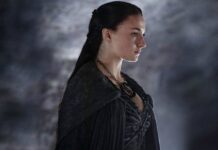














![[Book Review] The Blade Itself (The First Law Trilogy) by Joe Abercrombie](https://bendthekneegot.com/wp-content/uploads/2018/01/1516047103_maxresdefault-218x150.jpg)








